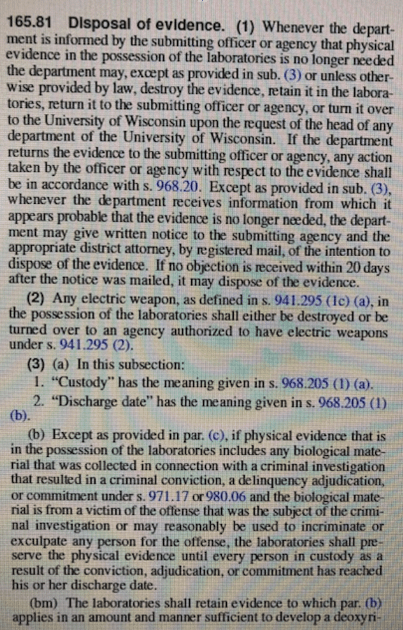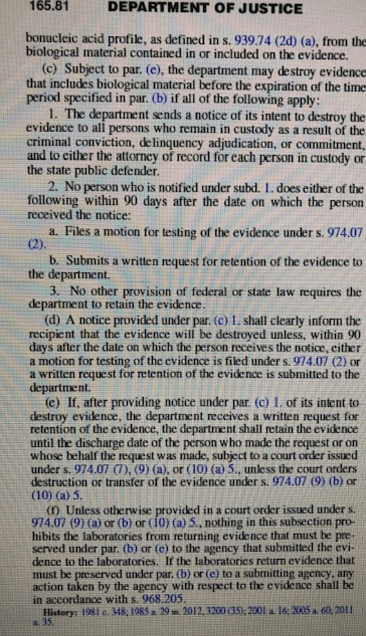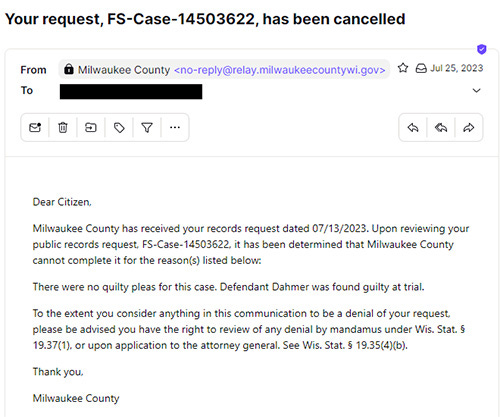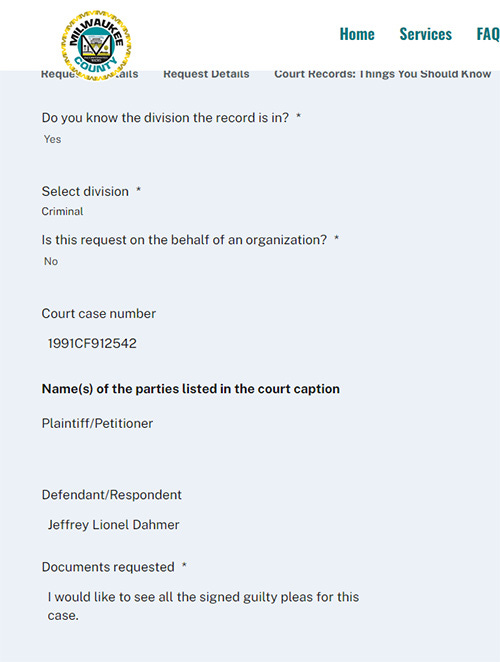Jeff Dahmer's "trial" was strange.
His attorney, Gerald Boyle, made decisions that a defense attorney wouldn't have made if he were defending his client. This is because it wasn't a real trial, but rather, a show trial. See what we've uncovered about Konerak Sinthasomphone, Curtis Straughter, Eddie Smith and Richard Guerrero.
22 July 1991 - An Illegal Search and the Arrest That Followed
According to the official narrative, on the night of 22 July, 1991, Tracy Edwards - with a handcuff around one wrist - flagged down the police and directed them to apartment 213 at 924 N. 25th Street in Milwaukee, Wisconsin. The purpose of the police visit was to get the key to the handcuffs he claimed Jeff Dahmer had placed on him.
Jeff Dahmer did not invite the police in to search his property for “evidence” and the police had no reason to suspect anything else was going on. The object of the visit was to get the key to the handcuffs that were on one of Tracy Edwards’ wrists.
The police had no business rummaging through Jeff Dahmer’s dresser for the purpose of finding incriminating evidence. They just “accidentally” happened to do that and then arrested him afterward. If they hadn’t rummaged through his dresser they wouldn’t have had any reason to suspect anything was going on in the apartment. If Jeff Dahmer had given them the key to the handcuffs they would have left.
Therefore, this was an illegal search. Keep that in mind as we move forward.
25 July 1991 - First Court Appearance
6 August 1991 - Second Court Appearance - Gerald Boyle Recommends Disposing of the Evidence
During Jeff Dahmer’s second court appearance on 6 August 1991, Gerald Boyle recommended that key biological evidence be returned to the families.
This was just 15 days after the arrest:
There is nothing there to test and he wishes to have those parts released and not be retained. I would furthermore state for the record that I have this date contacted…if one reads the criminal complaint…much of the identification is done by a forensic odontologist. I am confident that the odontologist has retained sufficient information for which somebody in the future…need be or at that time ever came to review his work product…determine whether or not he is correct in his conclusions and opinions. I have no reason at this time to proffer why Dr. Jentzen has to retain anything further*, and obviously therefore they can use her own discretion on returning whatever they wish to return to the members of the family.*
For a case of this magnitude, 15 days is extremely early to be releasing key forensic evidence. In fact, it violated a Wisconsin statute regarding the disposal of evidence. Here's what Wisconsin statute 165.81 states about the disposal of evidence. This statute has not changed since 1991 (we checked that):
Note that part (2)(b) states the physical evidence must be preserved until every person in custody as a result of the conviction (i.e. Jeff Dahmer) has reached his discharge date.
The rules around otherwise being allowed to destroy evidence including biological evidence are listed below - parts 1, 2 and 3 must be met. There is no single federal law that governs retention of biological evidence for all crimes and states (see part 3 below). State laws generally dictate the requirements, as shown in Wisconsin statute 165.81 here:
At this early stage, the “trial” had barely even started. Given that, they certainly wouldn’t have known what Jeff Dahmer’s future discharge date would be. The result of this decision by Gerald Boyle meant there would be no key physical evidence to re-examine down the line.
Are we to believe that District Attorney E. Michael McCann, the assistant DA Gregory O'Meara, the judge, and others present didn't realize Gerald Boyle was violating Wisconsin statute 165.81 when he recommended disposing of the evidence before the "trial" even began?
Perhaps they never had any physical evidence and this was a way to make sure nobody ever asked to see it. Remember the tiny skulls? They also claimed to have Curtis Straughter's hands and penis and "Konerak's" skull.
22 August 1991 - Third Court Appearance - Jeff Dahmer Gives Up His Right to a Preliminary Hearing
On 22 August, 1991, one month after his arrest, Jeff Dahmer gave up his right to a preliminary hearing:
What is a Preliminary Hearing?
A preliminary hearing is the 'trial before the trial', where the judge decides if there is enough evidence for the defendant to stand trial.
Background reading:
Preliminary Hearing (DOJ)
Preliminary Hearing (FindLaw)
What did Jeff Dahmer waiving his right to a preliminary hearing mean?
It meant that Jeff Dahmer’s attorney, Gerald Boyle, wouldn’t have the opportunity to cross-examine the curious confession that shows his client admitting guilt after merely being shown photos and responding with statements like, “Yeah, that looks like the guy I killed”.
It also meant that Gerald Boyle wouldn’t have been able to question the fact that the confession contained another man’s Social Security number.
Why didn’t Gerald Boyle care about these anomalies in the confession?
If there had been a preliminary hearing and proper cross examination, would the judge accept this confession as sufficient evidence? If not, the charges would have probably been dropped.
Was Gerald Boyle defending Jeff Dahmer, or not?
Interestingly, Gerald Boyle said there was going to be a preliminary hearing and that everything would be done in accordance with the law. Gerald Boyle then did the opposite:
Background reading:
How the police investigate crimes
First Degree Murder Defenses - FindLaw (Also explains the insanity defence used in this case)
Was this investigation thorough enough and did the confession provide the required evidence to bring these charges forth?
Weren’t Jeff Dahmer’s neighbour, Vernell Bass, and the manager of the Oxford Apartments, Sopa Princewill, worthy of further questioning as witnesses?
Given the irregularities of the confession and the fact that Dr Palermo even testified that Jeff was a liar and embellished his facts, was Jeff Dahmer fit to provide a reliable confession?
The following is an extract from the book Monster by “first on the scene” reporter Anne Schwarz:
Again, was Gerald Boyle defending Jeff Dahmer, or not?
Gerry Boyle suspended from law practice for health reasons (jsonline.com)
Perhaps the defence of mistaken identity would have also been appropriate in this case given the number of victims without remains, the lack of forensic or even circumstantial evidence in some cases, and a sketchy confession.
10 September 1991 - Fourth Court Appearance - Plea Changed To Guilty But Insane
On 10 September 1991, Jeff Dahmer changed his plea from not guilty to guilty but insane. Now, there was no need to prove guilt (together with the constitutional rights given up in the previous third hearing). Instead, there would be an “insanity” trial to determine whether Jeff Dahmer would spend the rest of his life in prison or a mental institution.
13 January 1992 - Motion Hearing
On 13 January 1992 there was a motion hearing. It’s essential to understand what happened during that motion hearing.
What Is a Motion Hearing?
A motion is a written request or proposal to the court to obtain an asked-for order, ruling, or direction. When you become involved in a lawsuit, you may want the court to agree to something outside of the normal litigation process.
You can read more about motion hearings in What is a Motion? (Find Law)
What Was the Purpose of the Motion Hearing Before Jeff Dahmer’s Trial?
In the 13 January 1992 motion hearing, a number of motions were discussed, including the selection of the jury and location of the trial, put forward by defence attorney Gerald Boyle.
There were also requests to withdraw two motions:
There was a request to withdraw a motion to suppress physical evidence. This was about the confession. In other words, Gerald Boyle wanted to admit the confession. (The confession was considered physical evidence because it had been signed by Jeff Dahmer.)
There was also a request to withdraw a motion to suppress statements to the media and the public at large about what was happening with the case.
In other words, Jeff Dahmer’s lawyer, Gerald Boyle, wanted to admit the confession as evidence and he wanted to be able to make statements to the media about the case.
These requests were approved. Gerald Boyle could now admit the confession as evidence and make statements to the media.
You can watch the televised 1992 motion hearing here. Gerald Boyle speaks quickly using legal jargon. However, YouTube gives you the option to read the transcript.
But, Why Was There a Motion to Suppress the Confession To Begin With?
There was a motion to suppress the confession because there was a concern about admitting the confession as evidence due to a legal technicality. That legal technicality was this: The confession followed an element of unlawful activity by police, the above mentioned illegal search.
In his argument to admit the confession, Gerald Boyle quoted previous legislation (Brown v. Illinois 422 U.S. 590 (1975)). The decision made by the Supreme Court in Brown v. Illinois is the following:
The State Supreme Court, though recognizing the unlawfulness of petitioner's arrest, held that the statements were admissible on the ground that the giving of the Miranda warnings served to break the causal connection between the illegal arrest and the giving of the statements, and petitioner's act in making the statements was "sufficiently an act of free will to purge the primary taint of the unlawful invasion..
In other words, statements made after the arrest in this case were admissible despite the unlawful invasion because 1) the petitioner had been given the Miranda warnings and 2) the petitioner wasn’t coerced into making the statements.
In the motion hearing, Gerald Boyle points out that Jeff Dahmer had been given the Miranda warnings and that he had given up his constitutional rights.
Why Did Gerald Boyle Want to Admit the Confession?
Gerald Boyle argued that the confession should be admitted because the actual physical evidence was “incredibly revolting.” In other words, Gerald Boyle didn’t want to present any physical evidence.
Did they have any physical evidence?
To sum up, Boyle is arguing that other types of physical evidence aren't necessary since they have the confession. Boyle cites Brown v. Illinois, 422 U.S. 590 (1975) to argue that the confession can be used.
Background reading:
Miranda Rights
Attenuation
Gerald Boyle wanted to use the confession only even though the point of the defence was to prove that Jeff Dahmer was insane.
Wouldn’t bringing in actual physical evidence have made it easier to prove Jeff Dahmer was insane? Was Gerald Boyle indeed trying to prove Jeff Dahmer was insane? Why was Gerald Boyle so eager to dispose of the physical evidence?
If Gerald Boyle was indeed trying to prove Jeff Dahmer insane why didn't he call Lionel Dahmer to testify? After all, Lionel Dahmer supposedly wrote a book detailing Jeff's ''descent into madness."
The video of the 13 January 1992 motion hearing later confirms that Jeff Dahmer had signed 15 guilty pleas. When he did that, he gave up his right to have those charges proven. Here's an excerpt of the transcript from this televised motion hearing video:
Did Mr. Boyle explain that to you, sir?
Yes, he did. (Jeff Dahmer)
Do you further understand, sir, that when you plead guilty to these offences there’s a certain group of rights that you’re giving up. You’re giving up the right to remain silent, the right to confront the witnesses against you, the right to call witnesses on your own behalf, the right to a jury trial, and the right to require the state to prove each and every element of the offence charged beyond a reasonable doubt. Are you satisfied that you understand all of that, sir?
Yes, your honour. (Jeff Dahmer)
Do you have any questions, sir?
No, I don’t. (Jeff Dahmer)
Mr Boyle, have you had ample opportunity to go over all these matters with your client?
Without question your honour. (Gerald Boyle)
Court then finds the plea is intelligently, freely, and voluntarily made.
We asked the court for a copy of those signed guilty pleas. Here's the response we received:
Our original request to see the signed guilty pleas:
As noted above, Jeff was not “found guilty at trial” since he waived all his constitutional rights to a fair trial to prove guilt. It was only ever about trying to prove “insanity”. The video of the motion hearing clearly states that Jeff Dahmer signed 15 guilty pleas.
As previously discussed, Jeff Dahmer had already given up his right to a preliminary hearing, the first stage in the process to prove guilt. This is why the many anomalies in the confession were not in question. The case was to prove insanity only, not to prove guilt. However, insanity pleas are rarely successful and external pressures to make the “right” decision (i.e., sane) were immense.
If the trial had followed the traditional route, the case might have been dropped on a technicality. If the confession had been properly cross-examined at a preliminary hearing, the impossible fabrications contained in it would have been revealed.
Again, was Gerald Boyle defending Jeff Dahmer or not? What exactly was Boyle doing?
27 January 1992 - Trial Starts with jury selection
17 February 1992 - Sentencing
Here the Court TV sentencing video, where Jeff is ‘convicted’ of 15 homicides.
Interestingly, background checks show no arrest records for Jeff in Wisconsin, and only the Ohio arrest and conviction shows up in these verified searches.









The ‘legal’ process did away with the need to prove any of the impossible tales & anomalies in this story. Convenient?
Listen carefully at the Motion hearing and hear Boyle even trying to avoid the 3 requirements that must be met under Illinois, unchallenged (as that was Boyle’s job, to challenge).